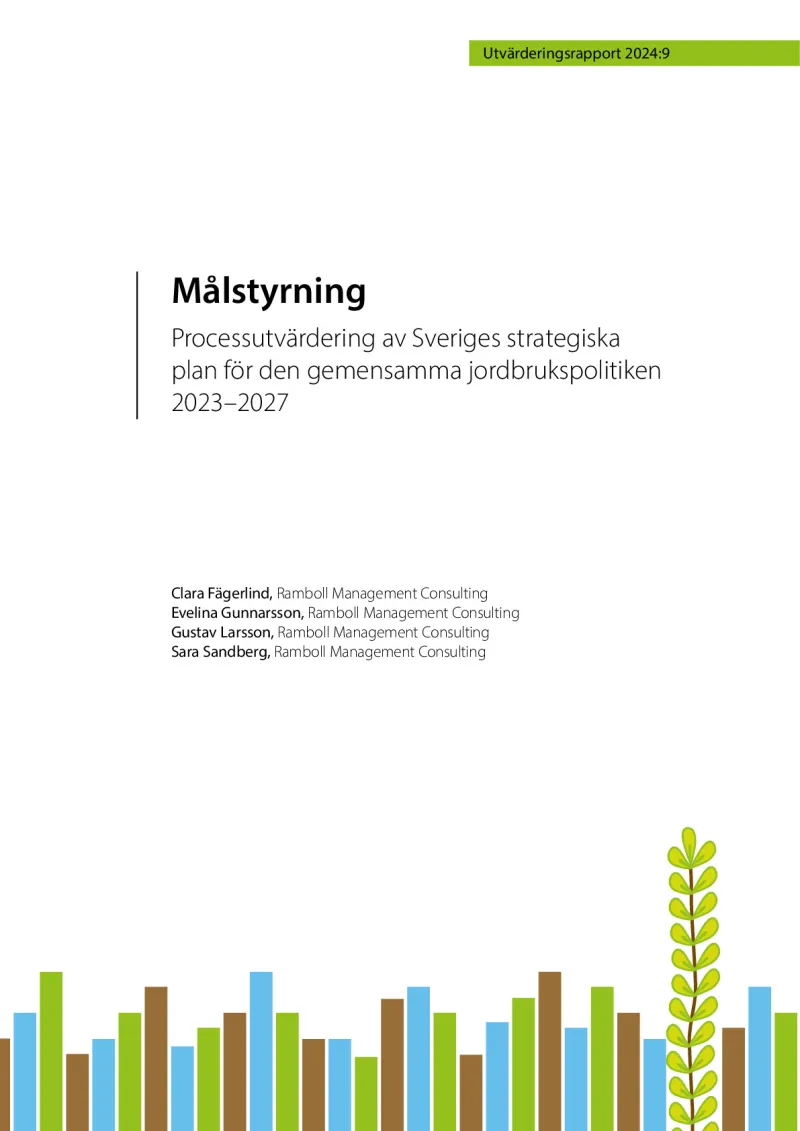Process evaluation of Sweden’s CAP Strategic Plan 2023-2027: Performance management
The management based on objectives of the CSP aims at working proactively and steering implementation so that Sweden at the end of the period, 2027, meets its set objectives and that the EU funds are fully utilised.
- Sweden
- 2014-2022
- Cross-cutting impacts

The report is part (the third) of a more comprehensive process-oriented evaluation structured in 3 studies and related to the Swedish CSP 2023-2027. The objectives of the evaluation, which takes into consideration the 2023-2024, are:
- identify processes and conditions that enable and hamper the implementation of the strategic plan;
- examine how well the management by objectives fulfils its purpose;
- examine how collaboration and the division of responsibilities work; and
- identify areas for improvement and contribute to learning.
This process evaluation takes into account the evaluation criteria of effectiveness and efficiency. The report is based on interviews with the Swedish Board of Agriculture and the administrative authorities, on document reviews and on information gathered at meetings at the Swedish Board of Agriculture. The analytical framework takes into account factors of success. The evaluation questions were developed by the Board of Agriculture. These overall questions have been broken down into several sub-questions to provide the necessary information to be able to answer all the questions.
Several limitations have affected both data collection and analysis. One of the biggest difficulties is that the performance management process itself is continuously updated. This has made it difficult to get a static picture of the status of the processes at a certain point in time and has thus affected our ability to make precise analyses of the process's development. Another limitation is that the evaluators have not carried out an in-depth analysis of how the processes and measures in different types of aid vary depending on, for example, how the aid achieves its objectives. A third limitation is that the evaluators have not made any quantitative analysis of the cost-effectiveness of performance management. An analysis of the pure cost-effectiveness would have required a different design of the evaluation method and data collection, a design that required more resources than the evaluation had access to.
The following main findings stem from the report. First, the evaluation results show that performance management contributes to fulfilling the overall CAP Strategic Plan objectives: to contribute to full utilisation of the allocated EU funds and to achieve the objectives of improved management of plan implementation within financial boundaries, better quality in the information used for performance management decision-making, and providing a sustainable workload for staff over time. The evaluator concludes that the Swedish Board of Agriculture generally has a well-functioning internal structure for performance management, but there are opportunities to further strengthen and develop the work. In addition, processes need to be improved in order to ensure that chosen measures are efficient and have a clear aim and purpose. The evaluation shows that program forecasts can be improved through clearer visualisations of the information and a deeper analysis. This will make it easier for those involved to quickly understand and act on relevant information. Finally, there is a need to improve the collaboration between the Swedish Board of Agriculture and the administrative authorities, especially with regard to the County Administrative Boards. Better collaboration within the performance management process would improve the consideration of regional perspectives and the different needs of beneficiaries. This can lead to a better knowledge base and improved adaptation and accuracy of measures within performance management.
Author(s)
Ramboll Management Consulting: Clara Fägerlind, Evelina Gunnarsson, Gustav Larsson, Sara Sandberg